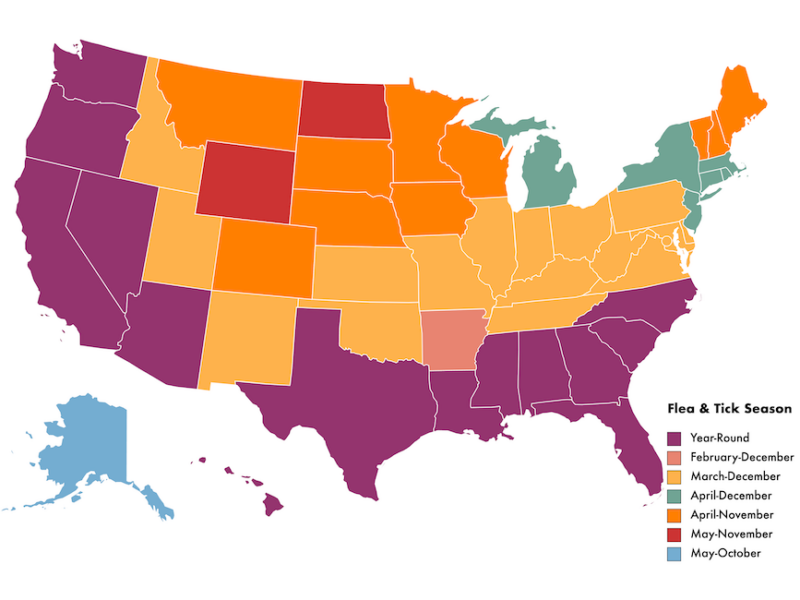
How to Prevent and Eliminate Fleas and Ticks
Flea infestations can be not only annoying for both dogs and cats and humans, but also very dangerous. Problems caused by fleas may range from mild to severe itching and discomfort to skin problems and infections. Anemia may also result from flea bites in extreme circumstances. Furthermore, fleas can transmit tapeworms and diseases to pets.
Ticks are parasites that feed on the blood of their host, which can be an animal or a human. Ticks are efficient carriers of disease because they attach firmly when sucking blood, feed slowly and may go unnoticed for a considerable time while feeding. Common and serious tick-spread illnesses are:
- Rocky Mountain spotted fever (RMSF): a bacterial disease spread through the bite of an infected tick. Most people who get sick with RMSF will have a fever, headache and rash. RMSF can be deadly if not treated early with the right antibiotic.
- Lyme disease: a bacterial disease caused by Borrelia burgdorferi and rarely, Borrelia mayonii. It is transmitted to humans through the bite of infected blacklegged ticks. Typical symptoms include fever, headache fatigue, and a characteristic skin rash called erythema migrans.
Flea and Tick Allergy Dermatitis
Animals that are allergic to flea bites can suffer torment for weeks from one single bite and tick bites can become infected. Flea allergy dermatitis (FAD) is a leading cause of allergic reactions in dogs. In a reaction, the dog’s immune system overreacts or is hypersensitive to an antigen that is normally harmless. FAD is a common cause of itching in dogs.
How to Prevent and Eliminate Fleas and Ticks
For every parasite you see on your pet, there are hundreds more in the environment. There is no perfect control. By educating yourself on available products, and using the best products for your situation, you can reduce the chances that your pet will be infested with fleas or become a meal for ticks.
Some flea and tick products repel mosquitoes, as well.
When choosing a control product, examine the length of the flea, tick and mosquito season in your area. Fleas and ticks pose a threat to pets year-round, but are most active during the warmer months, starting as early as March in some areas of the United States. Find your state on the map shown here to learn where and when your pets are most at risk for fleas and ticks.

Flea & Tick Season, Courtesy of the American Kennel Club
Selecting the Best Flea and Tick Treatment
To select the best flea and tick treatment consider:
- the severity and stages of the problem
- the type of external parasites involved
- the species, age and health of the pet
- any chemical sensitivities in the household
Many people find that they need to treat the yard and the house, as well as the pets, to achieve adequate control.
Understanding Product Labels and Ingredients
Warning: It is important to understand that more potent products may have an increased risk of side effects. Never use a flea, tick or mosquito product for a cat unless the label specifically states that it is safe for cats. Many dog products are very dangerous for cats.
The product choice is made by balancing safety, efficacy, duration, addition of an insect growth regulator, and whether or not the product can be used on cats or dogs.
Misuse and overdose of insecticide products can significantly increase the chances of side effects. Be aware that individual pets may react to any given insecticide product. If a negative reaction does occur, the product should not be used again. Switching to a different product may solve the problem.
When reading product labels, look for the:
- active ingredients
- the species and age of animal that the product is intended
- types of parasites killed
- whether the product includes an adulticide, an insect growth regulator, or both
Adulticides are insecticides that kill adult insects. Insect growth regulators are insecticides that help to reduce fleas in the environment by preventing eggs from hatching and larvae from molting. The insect growth regulators (IGRs) are of vital importance to reduce fleas in the environment and eliminate them before they have a chance to jump on your pet. They are a simple, easy method of flea population control and an excellent addition to flea products that kill fleas on your pet.
Flea and Tick Prevention and Treatment Methods
Flea and Tick Collars for Dogs
Flea collars are a safe and effective way to control fleas on dogs. While they start working immediately, the active ingredients in flea collars spread over time to cover the entire body for maximum protection. They are a long-lasting form of flea control, from 6 to 8 months depending on the collar.
Flea collars work by either emitting a pesticide into the area around your pet or releasing one that is absorbed by your pet's skin. While some are effective, many, unfortunately, only protect a very small portion of the animal, generally around the neck area. Additionally, prolonged use is more likely to cause a localized skin reaction where the collar is worn. Flea collars can be quite handy in the event of a flea infestation; simply toss in your vacuum canister or bag for a more effective vacuuming experience.
| Shop Dog Flea & Tick Collars |
Flea and Tick Shampoos and Sprays for Dogs
Traditional methods of flea control for pets include shampoos and sprays. Although effective, these products often only kill the adult parasites and have little or no residual activity. So, new ticks or fleas can re-infest your pet in a matter of days. Traditional methods are time consuming and often messy.
Flea shampoos contain additional ingredients that repel or kill fleas. There are also flea shampoos that contain natural ingredients, however many of these products may not provide the same levels of efficacy as medicated products. While flea shampoos can help, they are not effective as your only flea prevention strategy.
| Shop Dog Flea & Tick Shampoos |
There are a variety of sprays on the market, and which you select will be based on your level of flea infestation. Some sprays are designed to be sprayed directly onto your pet. Others are designed to be sprayed on furniture, bedding or carpet. Still others are exclusively for use outdoors. Be sure to read the manufacturer's guidelines for application directions.
| Shop Dog Flea & Tick Sprays |
Flea Pills and Oral Treatments for Dogs
Flea pills are oral insecticides that help control, treat and prevent flea infestations in dogs. There are several different types of flea pills commonly prescribed by veterinarians.
Each has a different active chemical ingredient that targets fleas in a unique way. Some flea pills kill adult fleas, others kill larvae, and some inhibit a flea’s ability to lay eggs. Knowing which part of the flea life cycle the pill targets is essential for effective flea control.
The type of flea pill that is best for your dog depends on your situation. For example, select a fast-acting flea pill that only stays in your dog’s system for a few days if your dog is suffering from flea allergy dermatitis.
Oral prescription flea solutions work in different ways. Most of these treatments are very effective because they contain both an insecticide, which kills adult fleas, as well as a hormone growth regulator which targets eggs and larvae.
Hormone growth regulators kill fleas over long periods of time by disrupting the flea's exoskeletal development. They can be effective for all growth stages by preventing the hatching of eggs and interfering with the molting process of flea larva. However, they don't necessarily kill adult fleas, so they are often used in conjunction with other flea products.
Rapid control on the pet can be achieved with Capstar.
When you have a flea infestation, you need to kill fleas fast. Capstar is available without a prescription and starts killing fleas within 30 minutes. Unlike topicals, shampoos and sprays, Capstar is an oral tablet that starts working from the inside out. It is safe to administer daily to kill new fleas as they appear on your pet. If your pet gets re-infested with fleas, it is safe to administer another dose as often as once a day. Capstar kills adult fleas and are indicated for the treatment of flea infestations on dogs, puppies, cats and kittens 2 pounds of body weight or greater and 4 weeks of age and older.
| Shop Dog Flea & Tick Oral Treatments |
Flea and Tick Spot-on Treatments for Dogs
Spot-on treatments have the advantage of becoming active quickly and staying active for a specified period of time. Spot-on treatments are a liquid medication applied directly to your dog's skin, in an area that your dog cannot lick. Once applied, the ingredients are absorbed into the oil glands and are spread out and begin to kill fleas all over your pet's body.
| Shop Dog Flea & Tick Spot Treatments |
Flea and Tick Home Sprays and Fogger Treatment
Help protect your home and family from parasitic pests with flea and tick home sprays. Home spray works to kill fleas, bed bugs, dust mites, brown dog ticks and other household pests on contact for up to two weeks.
Adams Plus Flea & Tick Indoor Fogger kills today's fleas and prevents tomorrow's fleas from growing up to bite. It effectively breaks the flea life cycle and inhibits flea reinfestation for up to 7 months.
| Shop Dog Flea & Tick Home Treatments |
Tweet
Updated April 26, 2021









